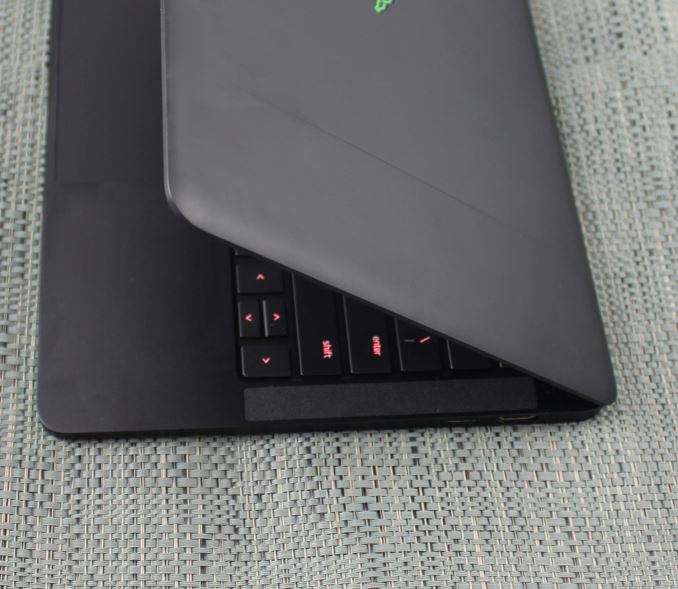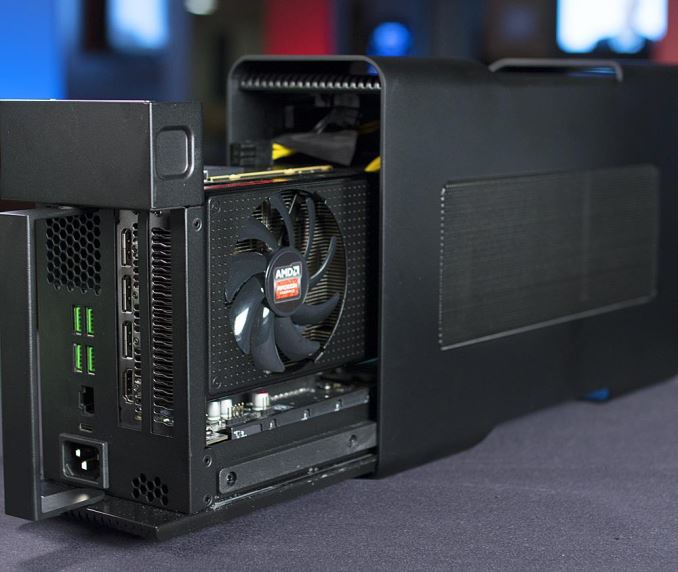The Razer Blade Stealth Review: Razer Takes On The Ultrabook
by Brett Howse on March 29, 2016 8:00 AM EST- Posted in
- Laptops
- Razer
- Skylake
- Razer Blade Stealth
- eGFX
- Razer Core
- Skylake-U
Final Words
So what is the verdict on Razer’s first step into the Ultrabook world. As with most devices, they’ve done some things well, some things great, and some things not so great. The first great part is the design. The Stealth is basically a mini-version of the Blade 14, with an almost identical look and feel. The matte black finish looks wonderful on the CNC aluminum chassis, at least until it gets a few fingerprints. Razer has put their same hidden cooling vent into the hinge of the notebook, concealing it from view for a cleaner overall look, and other than the green Razer light-up logo, the design is very understated which is something that has its own appeal.
The keyboard is a marvel of engineering. Razer is certainly not the first company to do a backlit notebook keyboard, or even a backlit keyboard that can change color, but they are the first to do individual backlit RGB keys on an Ultrabook, and the result is spectacular. The Razer software lets you pick several stock options for colors and patterns, or you can use the Chroma Configurator to set pretty much anything you want. It is completely customizable, and this is something that’s been on the desktop space for some time, and it’s great to see it come to the notebook.
Razer has also outfitted the Stealth with one of the highest density displays around. Packing a UHD resolution into a 12.5-inch panel may seem like overkill, but side by side with the QHD version the difference is very apparent. It is also a full Adobe RGB gamut panel, which has an up-side in a much wider color gamut, but is also a downside due to the lack of good software support from Windows.
The performance of the Intel Core i7-6500U CPU is very good, and with the Stealth there are no lower tiers in terms of performance. Most devices charge a lot more for the Core i7 model, so it’s great to see Razer include it across all models. I do feel that an Iris based processor would have been nice, even as a more expensive option, but that is not in the cards with the first generation, at least for now. Otherwise the 8 GB of RAM is adequate for today, but with Skylake’s support of DDR4, 16 GB of RAM in an Ultrabook is quickly becoming the new normal. Storage performance is very good across the range, with all Stealths coming with NVMe PCIe storage. It’s a slower TLC SSD, but it still outclasses the SATA drives of last year.
Meanwhile Razer has also put a lot of engineering into the Stealth so that it could be used in conjunction with the Razer Core. This will be the world’s first external graphics dock over Thunderbolt 3, and they had to work closely with the entire Windows ecosystem crew – AMD, NVIDIA, Intel, and Microsoft – to enable this functionality in as seamless a method as possible. The Core is coming out this month, and will give a single-cable docking solution to significantly increase the graphical power of this device. At CES, I was able to see the Stealth attached to Core running Fallout 4, and it was a great experience. That said, I’m curious to see how much the U series processors hold back a really fast GPU, but regardless the experience is going to be a lot better than the limited graphics power you can fit in an Ultrabook.
In terms of construction, the Razer Blade Stealth really has everything done well. A great aluminum chassis, a thin and light design, and a top notch display. It has a great new keyboard lighting system, and support for external graphics over Thunderbolt 3. It even uses USB-C as the charging port, meaning the same cable that can charge your phone can charge the Stealth. There’s just one issue with it, and unfortunately it’s a big one.
Simply put, the battery life of the Stealth is not up to snuff with the rest of the Ultrabook competition. I knew going in that a UHD display with Adobe RGB support was going to hit the battery life hard, but I was a bit surprised just how poorly it fared. Even switching out displays for the lower-resolution sRGB QHD panel can't fully close the gap. If Razer wants to compete against the big OEMs in the Ultrabook space, they need to look at every single component in the Stealth, and find ways to save power on all of them. Eight hours is really the minimum on our light test for 2016, and even the QHD version falls well short of that.
It's really too bad, because the rest of the Stealth is a top notch laptop. Which does't have us writing off the laptop entirely – there are plenty of cases where it might still be a great machine – but if any scenario involves long periods away from a power outlet, it’s going to be an issue. Sure you can supplant it with USB battery packs, or find a place to plug in, but that’s not always a practical option.
Ultimately the Razer Blade Stealth is so close to being an awesome Ultrabook. If you don’t need battery life, you’ll want to check it out, but if you do value longer run times off of the battery, the Stealth is likely not the laptop for you.












66 Comments
View All Comments
ImSpartacus - Tuesday, March 29, 2016 - link
The battery life is disappointing, but at least seems to be alright otherwise.The keyboard appears like overkill, but at least you can presumably switch to a clean white light.
Keao - Tuesday, March 29, 2016 - link
It is overkill if you just want an ordinary ultrabook indeed. Needs to see if the glowing razer logo on the back can be deactivated too. (You can switch to plain white for sure given it works like the blackwidow chroma that I have)Battery life is really not great but is OK for the kind of processor they have isn't it? What's putting me a lil' off is the fact that to make it a gaming machine you do need to shell out at least some 750 additional bucks. Sure the external case will be re-used supposedly but I'm unsure about the future of this solution (Can evolve quite fast with a new Thunderbolt version and/or replacement of the PCI-e interface?)
zeroqw - Tuesday, March 29, 2016 - link
"Battery life is really not great but is OK for the kind of processor they have isn't it?" nope.. there are quite similar ultrabooks with at least 50% more battery life.Razer put a small battery in the laptop and if you add the backlit keyboard+glowing razer logo to the equation it just makes it even worse. Too bad because I love the design but the battery life is a deal breaker for me.
Duraz0rz - Tuesday, March 29, 2016 - link
You can turn off the logo LED thru Synapse.TheinsanegamerN - Tuesday, March 29, 2016 - link
Wont fix the battery being too small.DanNeely - Tuesday, March 29, 2016 - link
The battery size isn't the main problem; it's in the same general class as other 13" ultrabooks. The problem is that the laptop's efficiency is bad; if they were able to match their competitions efficiency they'd pick up an extra hour or two bringing the QHD model up to the average for a laptop of its size; and leaving the 4k one with only the penalty related to its ultra high res display (both more GPU work to drive it, and more transistors in the panel blocking a larger amount of the backlight).ImSpartacus - Tuesday, March 29, 2016 - link
I think Razer is struggling with both the pixel race and needing to justify the existence of Core.Honestly, a 768p display would be perfect for a 12.5" laptop (maybe 900p for a buy-up). But then you could say that Razer should've made the Core a smidge thicker and put a modest dGPU in there for gaming.
Spunjji - Wednesday, March 30, 2016 - link
Couldn't disagree more about the display. The sooner we get rid of low-DPI panels and the software ecosystem is forced to accept their existence, the better. The problem here isn't the display, it's a lack of engineering experience regarding power efficiency at Razer.BrokenCrayons - Wednesday, March 30, 2016 - link
I disagree with that. Higher resolution displays, while nice looking, offer little to no added functionality after reaching the point where it becomes necessary to scale the interface in order to retain visibility of objects displayed in it. At this point, they're part of the specifications for the sake of specifications war that's vital for product differentiation and marketing, but that's where it ends. Sacrificing capability as in the case of battery life to achieve a pointlessly high resolution shows particularly poor engineering. An Intel GPU in a 12.5 inch laptop display that is unable to drive games at much lower resolutions should be paired with a 1366x768 panel of decent quality with good viewing angles. Anything more than that won't benefit the end user regardless of how much they think they need more pixels.JoeyJoJo123 - Wednesday, March 30, 2016 - link
>should be paired with a 1366x768 panel of decent quality with good viewing angles.Except that's the thing. In the year 2016 there is no such thing as a 1366x768 panel of anything remotely decent quality. Panels of this size are just churned out by the factory for extremely low cost/low margin devices such as $300 laptops at Walmart.
If you're paying ~$1500 for a premium laptop, you should expect an arguably premium display. If you can't play the game at 2560x1440, then run the game at reduced settings, and if that's not enough, begin lowering the resolution, too.
Paying ~$1500 for a premium laptop also comes with the inherent notion you're paying for premium battery life, but you're not getting that here, either.
Replacing a good screen on a laptop with a bad battery leaves you with a laptop with bad screen and bad battery and now you have an even worse value proposition than before.